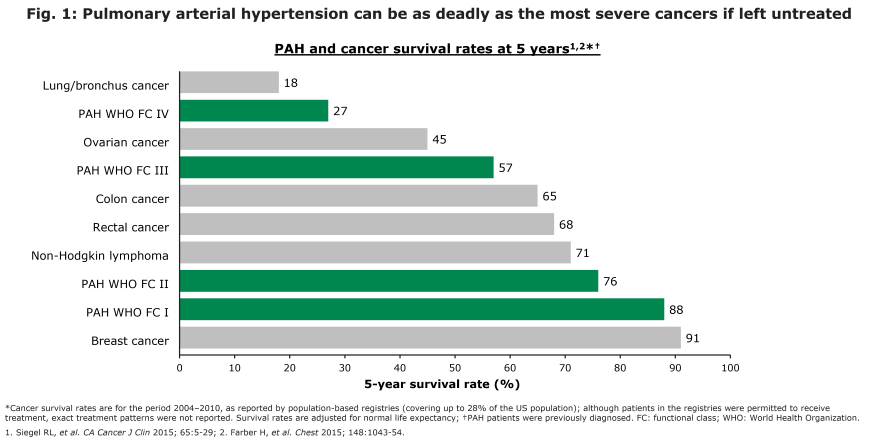Changing the way we think about rare disease management

My grandma on her 100th birthday with a congratulatory letter from the Queen!
The past 18 months have been an unsettling and, at times, scary period. Recently, my grandma celebrated her 100th birthday, a milestone made even better by her receiving a COVID-19 vaccine around the same time. Remarkably, on the same day that she was vaccinated, she contracted coronavirus. I’m very glad to say she’s now made a full recovery, but her experience really drove home the importance of the proactive protection we are seeking through measures such as vaccination programmes.
I hope the current attention on vaccines as a critical preventative public health measure may accelerate the movement towards actively maintaining health and adopting a proactive approach in healthcare, rather than waiting for someone to fall ill or show serious symptoms before intervening. Certainly in the treatment of Pulmonary Arterial Hypertension (PAH), my area of expertise in my role at Janssen, the importance of proactivity in diagnosis, management and treatment is clear, as we seek to minimise the risk of clinical worsening and improve long-term patient outcomes, in the absence of a cure.
In the last month, I have attended two key congresses for the Pulmonary Hypertension (PH) community – the European Society of Cardiology (ESC) Congress and the European Respiratory Society (ERS) Congress. Congresses such as these provide a fantastic platform to share new insights into patient care, and I am always excited to witness the latest scientific advancements being presented and exchanged within the community. PAH is a complex condition, with a multi-disciplinary team involved in referral, diagnosis and treatment. Engaging the teams involved in PAH care at these congresses (particularly cardiologists and pulmonologists, who play a central role in PAH management) and improving their knowledge of PAH may facilitate earlier identification and intervention in patients who may be at risk of developing PAH.
As you can imagine, COVID-19 was a high-priority topic throughout both events. For PH patients, an international patient survey on care during the pandemic recently revealed that 50% of patients were not in contact with physicians concerning questions or problems related to their PH and 14% of patients felt that their physical condition had deteriorated. It is perhaps not surprising that anxiety or depression was reported by two thirds (67%) of the participants.1
Diagnose early...
PAH can be a challenging condition to diagnose, meaning that many patients are diagnosed at a late stage, in some cases up to four years after onset of symptoms,2 contributing to poor prognosis and long-term outcomes. The term ‘hypertension’ may lead people to think of less serious and more manageable blood pressure disorders, but it is important to emphasise that PAH is an extremely serious disease, causing increasing damage to the heart over time and can result in heart failure.2 PAH survival rates are comparable to many common forms of cancer if left untreated (fig. 1).3,4

PAH is linked to a number of different conditions, so raising awareness within these clinical and patient communities is vital. Patients with connective tissue disorders are at significant risk and an important target for awareness campaigns, as are smaller at-risk groups, such as patients with HIV and portal hypertension.5 PAH can also be caused by cardiovascular diseases, such as congenital heart disease (CHD), heart defects that exist from birth. Advances in the treatment of CHD over the past few decades have led to more CHD survivors, who may then develop PAH over time once their heart defect is corrected.6 PAH associated with corrected CHD has a prevalence of up to 12%.7,8
There is no cure for PAH and therefore early diagnosis is a crucial first step in delaying disease progression. This requires multi-disciplinary collaboration among healthcare professionals to improve identification of people living with PAH. Our focus at Janssen on awareness and education for the clinical community may encourage increased screening of at-risk patients, to ensure earlier referral to PAH specialists. I hope this will speed up diagnosis of PAH and improve patient outcomes.
...and treat early
World Health Organisation functional class of PAH at the time of diagnosis is a strong predictor of survival9 - the earlier treatment is initiated, the better. I have written previously about the seriousness of disease progression in PAH, its symptoms and the significant challenge of reducing the time needed for diagnosis.
Early intervention is only part of the battle. Progressive diseases require proactive management throughout the treatment journey to reduce risk of progression events and, in the case of PAH, to avoid possible irreversible damage to the heart. Early interventions that target multiple pathways in the pathology of the disease help to lower patients’ risk of disease progression and proactive management helps to maintain a low risk status. For patients with severe diseases, even a small mitigation of risk could have an impact on their survival.
Finding solutions
Janssen is working hard to improve patient care and to ensure patients are receiving early intervention to help mitigate against the risk of disease progression. We are making the most of these key congresses to connect healthcare professionals with PAH experts. Our medical research also provides key insights and evidence to treating physicians on how and when to treat PAH.
Should you be interested, my colleague Jason Davies wrote previously about some of the work Janssen is doing to improve diagnosis times and patient outcomes, including clinical studies, digital tools and patient resources. We have exciting plans for PH Awareness Month in November, including new resources to help people living with PAH communicate effectively with their care team and updates to our online patient resource, PH Human. Watch this space!
Our bold ambition
Patients with rare cardiopulmonary diseases face enormous challenges in their lives, a fact made even clearer during a global pandemic. I take huge pride and responsibility in championing their cause and raising awareness of PAH, a serious, progressive disease. I am encouraged by the progress made and the insights shared during the ERS and ESC congresses, but our mission will not be complete until we have achieved our bold ambition of transforming PAH into a long-term, manageable condition so that patients can live a normal life.
+++
References
1. Godinas L, et al. Orphanet J Rare Dis 2021; 16:196.
2. Armstrong I, et al. BMC Pulm Med 2019; 19:67.
3. Farber H, et al. Chest 2015; 148:1043-54.
4. Siegel RL, et al. CA Cancer J Clin 2015; 65:5-29.
5. Frost A, et al. Eur Respir J 2019; 53: 1801904.
6. van Dissel A et al. J Clin Med 2017; 6(4):40.
7. Duffels MGJ et al. Int J Cardiol 2007; 120(2):198–204.
8. Engelfriet PM et al. Heart 2007; 93(6):682–687.
9. Park YM et al. Yonsei Med J 2014 ; 55(6):1526-1532.


